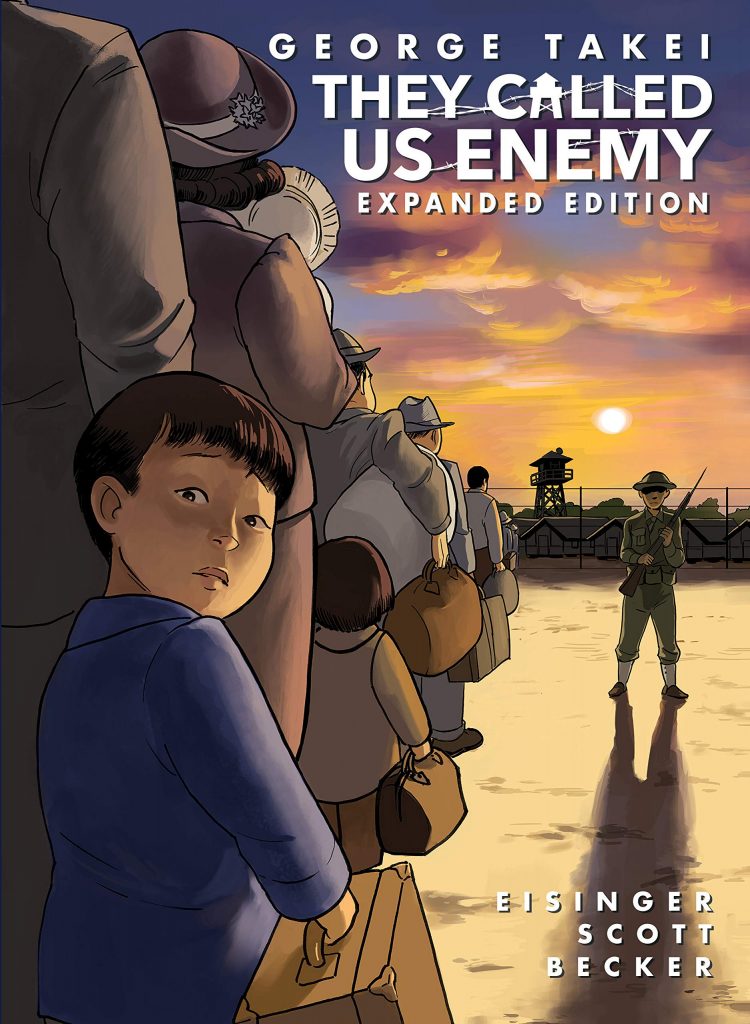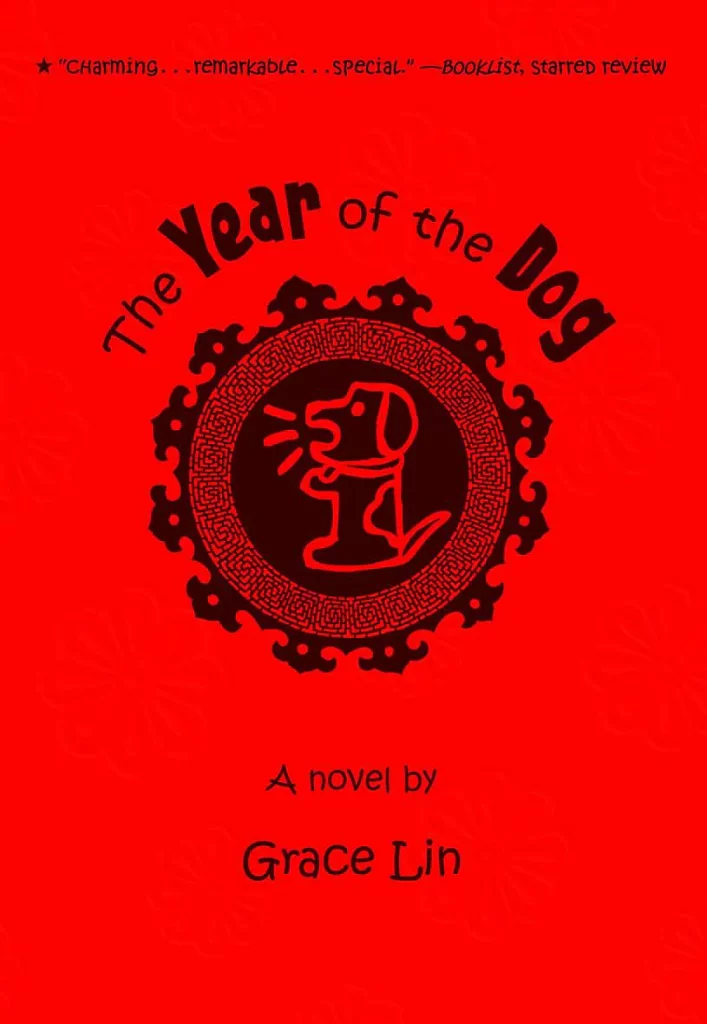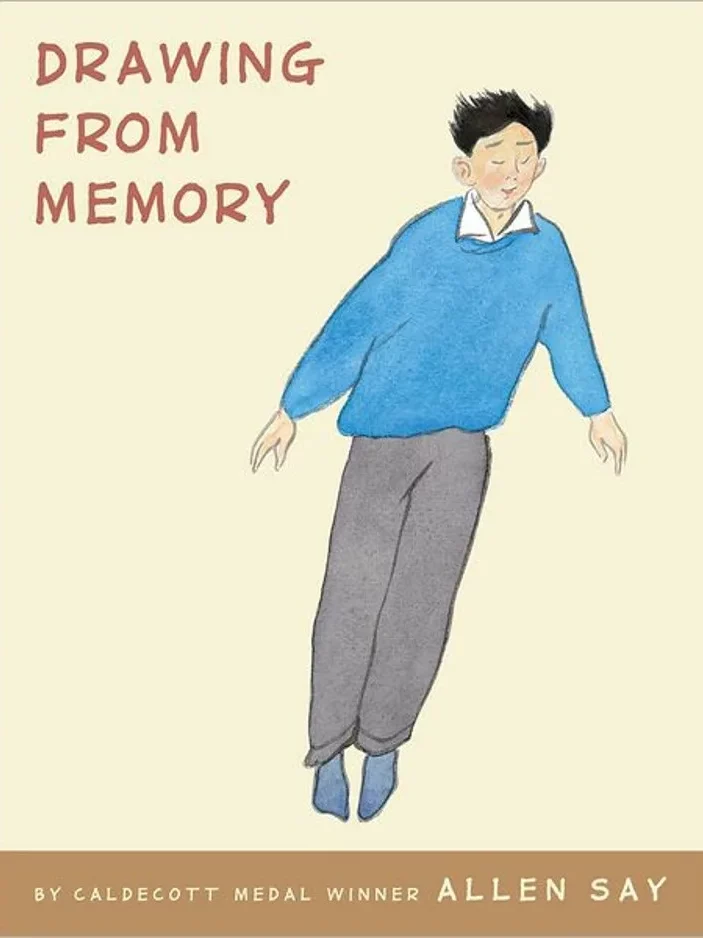
1. Bibliography
Takei, George, Justin Eisinger, Steven Scott, and Harmony Becker (illustrator). 2020. They Called Us Enemy: Expanded Edition. San Diego: Top Shelf Productions. ISBN 9781684068821
2. Plot Summary
George Takei, a Japanese American actor most famous for his stint in Star Trek as Captain Sulu, uses the graphic novel format to convey childhood memories of his family’s incarceration along with more than 120,000 Japanese Americans in military camps across the U.S. After the attack on Pearl Harbor and by order of President Franklin D. Roosevelt, all persons of Japanese ancestry were considered enemies to America, were taken from their homes with only the possessions they could fit in their suitcase, and were placed in these camps. Japanese Americans would stay locked inside for the next four years. When Takei’s family finally got out, his parents had to rebuild a new life from scratch, having lost their home and livelihood to Roosevelt’s executive order.
Takei’s graphic novel also shows how he rose up from the difficult post-internment adjustment to become a top-notch actor, activist, and influencer in America. While Takei’s biography is punctuated by his young self’s sweet naivete (for example, when young George and his family were trained from California to their first internment camp in Arkansas, his mother told him they were going on “vacation”), Takei also narrates the story through the lens of his current understanding of the difficulties faced by his parents and other detainees before, during, and after their incarceration (for example, the racial and political prejudice Japanese Americans faced, the misplaced guilt they felt after their incarceration, and the government’s erasure of their incarceration story). Takei ends his novel with a beautiful reconciliatory experience in which he visits Franklin D. Roosevelt’s home to deliver a speech about the hope he feels in America, despite its problems, and with a warning for readers to remember the unjust incarceration of Japanese Americans so that we don’t the incarceration of the innocent again.
3. Critical Analysis
I read the highly acclaimed March graphic novels two years ago, the trilogy about John Lewis, I didn’t think I’d ever find another book that was quite as detailed, historically accurate, authentic, and thought-provoking. Lucky for me, I was wrong. They Called Us Enemy is just as detailed, historically accurate, authentic, and thought-provoking as March was. George Takei’s graphic novel memoir is something exceptional.
While there has been a recent push to retell the Japanese American internment story, many newly published books on the subject have fallen flat because the authors are not the ones who experienced it. Takei did experience it firsthand, adding powerful authenticity to his story. Though his memories are those of an optimistic child who didn’t fully understand internment (i.e. the giant barbed wire fence around their new “home” is to keep the dinosaurs away), Takei reflects on his memories these many years later with wiser eyes and clearer understanding of events (i.e. his father didn’t leave work because he had a stomachache, but because he didn’t want to shake hands with Eleanor Roosevelt, the wife of the man who had imprisoned his family).
Other newly published books have also fallen flat because they don’t seem well researched. Takei and his coauthors have gone the extra mile to tell the story of Japanese American incarceration with depth. Not only do readers learn that President Franklin D. Roosevelt signed Executive Order 9066 seventy-four days after Pearl Harbor, but readers also learn about Lt. General John L. Dewitt who said, “a Jap is a Jap. . . it makes no difference whether he is theoretically an American citizen,” and Senator Tom Stewart who told his American listeners that “they [Japanese Americans] cannot be assimilated. There is not a single Japanese in this country who would not stab you in the back.” This deep retelling allows readers to understand how Executive Order 9066 was passed, why it was passed, and why it should never be allowed to happen again. Its depth provides thought-provoking fodder for reflecting, analyzing, and responding to the event and thinking through events happening today. Still, displaying an amazing degree of forgiveness and fairness despite his family’s four year incarceration, Takei also highlights the good things that President Roosevelt did during his presidency, showing his nuanced understanding of one of America’s political leaders. Takei presents Roosevelt as the complex person that he was with both weaknesses and strengths.
Takei also does a great job fleshing out his fellow Japanese Americans. Some of the others in internment camps only spoke Japanese, some—like Takei’s mother—spoke limited English, and some—like his father—spoke English fluently. Some were Japanese immigrants, some were issei (first-generation Japanese Americans), some were nisei (second-generation), and some were sansei (third-generation). Some answered the infamous mandatory camp questionnaires with “yeses,” determined to join the American troops during World War II, and some–like Takei’s parents—refused, becoming “no-nos” and being sent to the “disloyal” internment camp. Japanese Americans are certainly not a monolith in Takei’s memoir.
In displaying his own Japanese American internment story, Takei has inspired a new generation of Americans to think deeply about the damage that stereotyping can do, and the difference that just one person can make for bad or for good. While this isn’t the only Japanese American internment story being told today, it is one of the best. If you don’t yet have this book on your shelf, you should. Highly recommended.
4. Rewards and Review Excerpts
Asian Pacific American Award for Literature, 2020, Winner, Young Adult Literature
Cybils Awards, 2019, Finalist, Graphic Novels (Young Adult)
Booklist Editors’ Choice: Adult Books for Young Adults List, 2019, Nonfiction
Kirkus Best Young Adult Books List, 2019
From Publishers Weekly: “Giving a personal view into difficult history, Takei’s work is a testament to hope and tenacity in the face of adversity.”
From Booklist: “Takei, together with Justin Eisinger and Steven Scott, interweaves scenes of his adult realizations and reflections, as well as key speeches and historical events of the period, among the accounts of his childhood, which is very effective at providing context for those memories. . . . This approachable, well-wrought graphic memoir is important reading, particularly in today’s political climate. Pair with John Lewis’ acclaimed March series for a thought-provoking, critical look at the history of racism in American policies and culture.”
5. Connections
They Called Us Enemy pairs well with John Lewis’s March trilogy. Read both, discussing similarities and differences between Lewis’s and Takei’s experiences. Why is it important for us to learn about these two series of events in our country’s history? Which stories from each book were the most memorable to you? What is your biggest takeaway from reading these books?
After reading They Called Us Enemy, watch an episode or two of the original Star Trek series starring Takei. Why do you think Takei wanted to be cast in Star Trek so badly? Why do you think it continues to be such a popular franchise today? What underlying message did you learn from the episode(s) you watched?


